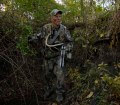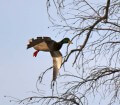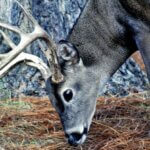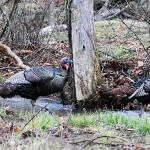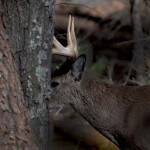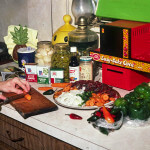John’s Note: One of the most-critical ingredients in recovering an arrowed deer is to know exactly what’s happened prior to, during and after the shot is taken.
 Once the arrow was found that Kevin had shot into the ground from his tree stand, the hunters searched for deer tracks and blood in the direction the animal had raced. The blood trail was found, and from the amount of blood, the hunters were encouraged at the possibility of recovery.
Once the arrow was found that Kevin had shot into the ground from his tree stand, the hunters searched for deer tracks and blood in the direction the animal had raced. The blood trail was found, and from the amount of blood, the hunters were encouraged at the possibility of recovery.
A few feet from the arrow Kevin found hair mixed in with the blood. The hair was medium length and a soft shade of brown. “That’s good,” Jim, the older hunter (see Day 4), said. “You probably hit the deer somewhere in the middle of his body. White or yellow hair that is long means you’ve probably gut-shot the deer, and that the recovery will take a long time, besides covering several miles. Short, dark brown or black hair indicates a back shot, which usually results in a long search too. But medium length brown hair is primarily found in the middle of the deer. So, yours should have been a good hit.”
As the hunters moved along the blood trail, Kevin stayed close to the ground with the lantern, while Jim stood up right behind him, carefully surveying the woods and marking the trail with flagging tape. “You missed something, boy,” Jim said. “Look here.” Pointing to the side of a tree, Jim showed Kevin a patch of blood about 3-feet off the ground. “That’s another good sign,” Jim explained.
 Although the trail was heavy with blood, it stopped 150 yards from where it had started. Jim took the lantern from Kevin and held it high to see the flagging tape behind him. From the trail of the tape, Jim determined the direction the deer was heading. Then looking in front of Kevin, Jim studied the terrain. “We’ll probably find your deer in the middle of that briar thicket,” Jim told Kevin. Using several pieces of flagging tape to mark the end of the blood trail, both men began to walk toward the briars, as they looked for additional signs. But they found none. Kevin took the lantern and headed into the thorns in the same direction the deer should have taken. Ten yards into the brambles, Kevin saw an ivory-colored antler and then the dead animal. The trailing had been successful.
Although the trail was heavy with blood, it stopped 150 yards from where it had started. Jim took the lantern from Kevin and held it high to see the flagging tape behind him. From the trail of the tape, Jim determined the direction the deer was heading. Then looking in front of Kevin, Jim studied the terrain. “We’ll probably find your deer in the middle of that briar thicket,” Jim told Kevin. Using several pieces of flagging tape to mark the end of the blood trail, both men began to walk toward the briars, as they looked for additional signs. But they found none. Kevin took the lantern and headed into the thorns in the same direction the deer should have taken. Ten yards into the brambles, Kevin saw an ivory-colored antler and then the dead animal. The trailing had been successful.
“You wouldn’t have found that deer if you hadn’t kept on looking after the blood trail stopped,” Jim commented with a smile on his face. “That’s where most hunters give up. But I have learned that sometimes when the blood stops, the deer will look for the thickest cover he can find to bed down. And when he does that, he won’t get back up, if you leave him alone long enough.”
 No hunters like to wound an animal. We all strive for a clean kill. But the truth is that many times we are forced to trail a wounded deer until it is recovered. Patience, perseverance, keen eyesight and a working knowledge of what to do after the shot paid off for Kevin, as they will for you.
No hunters like to wound an animal. We all strive for a clean kill. But the truth is that many times we are forced to trail a wounded deer until it is recovered. Patience, perseverance, keen eyesight and a working knowledge of what to do after the shot paid off for Kevin, as they will for you.
To get John E. Phillips’ Kindle eBooks and print books on hunting deer, “How to Hunt and Take Big Buck Deer on Small Properties,” “How to Hunt Deer Up Close: With Bows, Rifles, Muzzleloaders and Crossbows,” “PhD Whitetails: How to Hunt and Take the Smartest Deer on Any Property,” “How to Take Monster Bucks,” “How to Hunt Deer Like a Pro,” and “Bowhunting Deer: Mossy Oak Pros Know Bucks and Bows,” or to prepare venison, “Deer & Fixings,” click here.
For information on making jerky from your deer to provide a protein-rich snack, you can download a free book from https://johninthewild.com/free-books.

